Headphones with active noise cancellation (ANC) have reached a point where you can confidently isolate yourself from the world while on a morning stroll or enjoy an uninterrupted nap despite engine noise on your next redeye. Yet, despite continual advancements, ANC headphones still have some room for improvement as they struggle in some respects compared to the high standards of attenuation provided by protective hearing equipment. With this in mind, we developed our updated testing for noise attenuation performance using the 3M Peltor X5A as our point of reference (and uncovered some interesting differences along the way).
In this article, we'll explore the impact of headphone design on their noise attenuation capabilities and look at some of the tradeoffs users make when picking between noise cancelling headphones vs earmuffs. Check out the changelog if you just want to see what's new in v1.7, or our dedicated ANC article for a simpler look at how it helps you beat noise.
Starting at the End: Our Improved Testing
Our new noise isolation tests, developed for test bench v1.7, allow us to compare the performance of ANC headphones in a fairer and more approachable way. As ANC algorithms change how they handle background noise, a simple sine sweep isn't sufficient to evaluate the real-life performance of the headphones. Instead, we've updated our tests to use both pink noise signals and actual background scenarios to better test the noise attenuation capabilities of headphones with both data-focused and user-relatable metrics. Throughout our exploration-focused process, we took the opportunity to put a pair of 3M Peltor X5A earmuffs through our new testing to see how they fare against some of the best ANC headphones on the market.
Noise Cancelling Headphones vs Earmuffs
As you'd expect from purpose-made earmuffs designed and certified to attenuate very loud noises, the 3M Peltor X5A perform at the top of the pack. That said, ANC headphones can get quite close in performance and may perform better than earmuffs depending on the frequency ranges.

It should be noted that the language used to describe earmuffs varies quite a bit from that used to describe ANC headphones. Typically, earmuffs are advertised as hearing 'protection' or 'conservation' for use in loud work environments. On the other hand, ANC headphones are usually advertised to 'block out' or 'tune out' background noise, indicating a more casual use. Because of this, regardless of how ANC headphones perform, they aren't suitable as a replacement for earmuffs as hearing protection.
Noise Cancelling vs Passive Isolation
Before we get into the nitty-gritty details, we should first cover the two primary means of noise attenuation used by headphones: (active) noise cancelling and passive isolation.
Earmuffs (and any headphones without ANC) rely solely on passive isolation to block out noise. Simply put, the materials, shape, size, and seal of the earmuff or headphones are what block background noise from entering the ear.
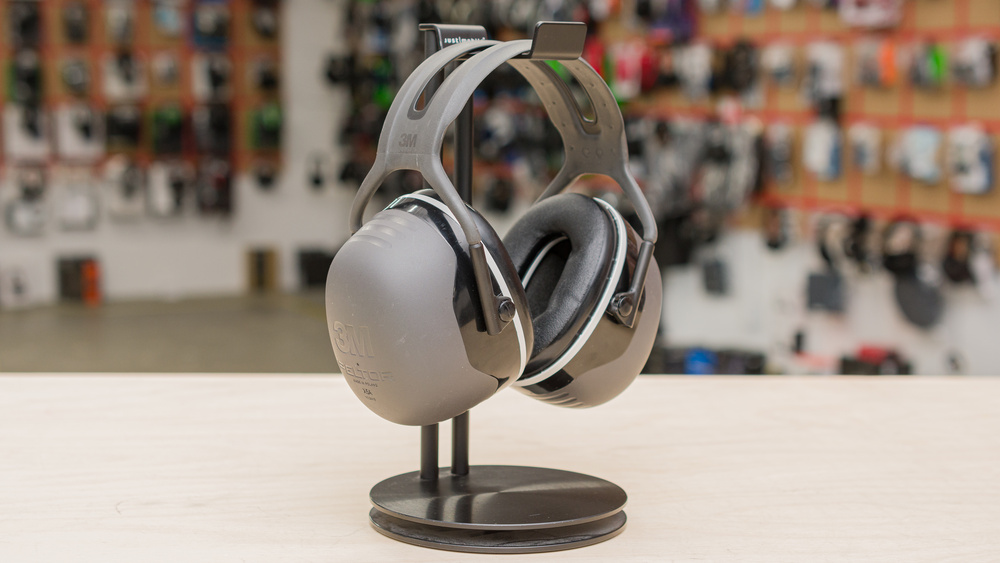 |
 |
ANC-equipped devices can enhance their noise attenuation by using a noise cancelling system to capture background noise with microphones, process the information onboard, and play back 'anti-noise' through the devices' speakers. This anti-noise is an inverted waveform of the background noise, which is designed to cancel out the background sound waves through destructive interference before they ever reach your ear. However, ANC works to varying degrees of success in practice.
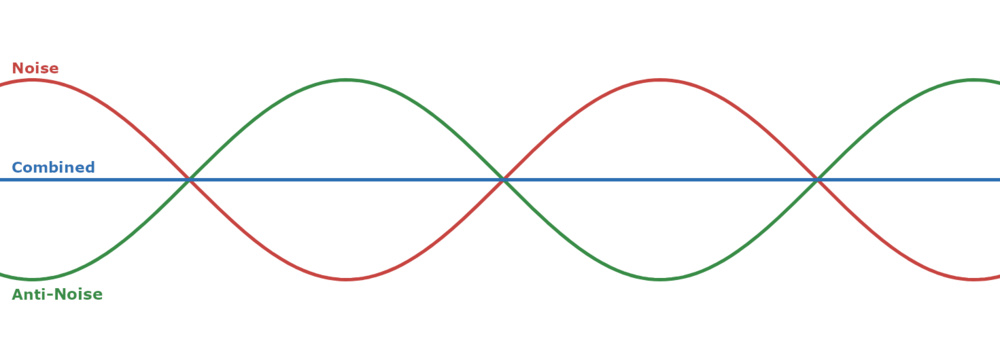
Although ANC can do a lot to reduce background noise, ANC headphones (or earbuds) still rely on passive isolation to combine both methods' effects for maximum noise attenuation. For this reason, we test both passive and combined noise isolation (for applicable devices) so that you can get a good idea of how products achieve their performance.
Comparing Performance
The following graph presents the full range pink noise attenuation performance of some popular ANC headphones. We use a pink noise signal because it allows us to account for the response time of some headphones' ANC systems (more on that later). In broad terms, the bass range includes noises like airplane noise and semi-truck engine rumble, while the mid and treble ranges include noises like people talking, dogs barking, or bus brakes screeching.
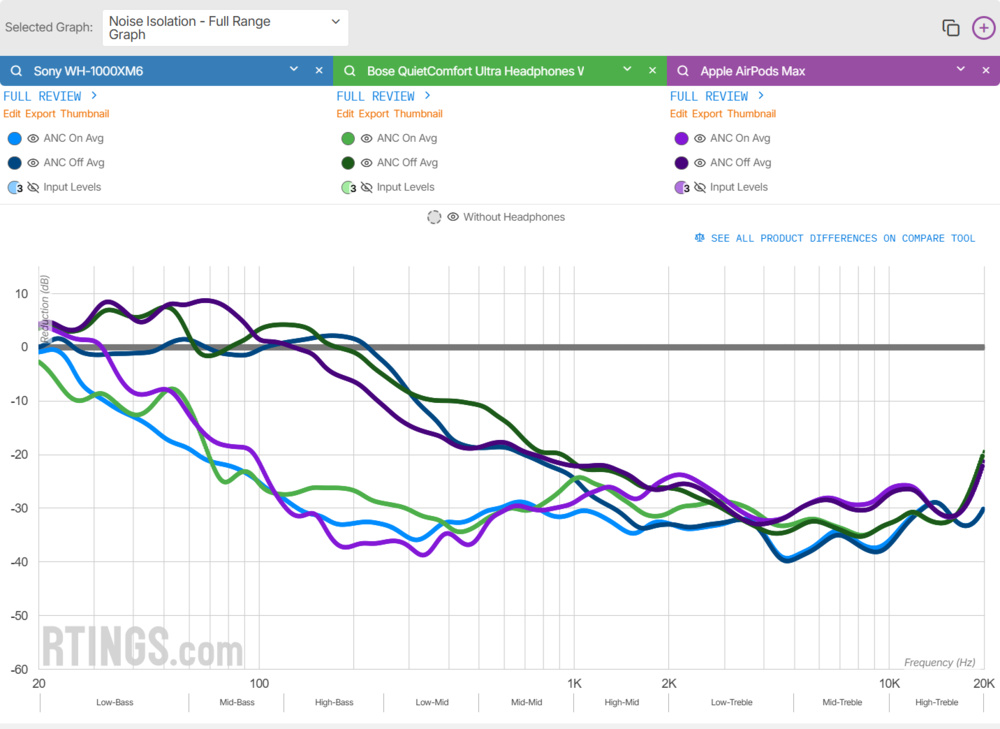
Keen-eyed readers might have noticed two main takeaways from the graph:
- ANC results in significantly improved bass range attenuation over passive isolation.
- ANC doesn't improve upper-mid and treble range attenuation over passive isolation.
In other words, ANC headphones use noise cancellation to improve lower frequency attenuation while relying on passive isolation to attenuate higher frequencies (above approximately 1kHz). With this in mind, let's look at the graph with only combined noise isolation, now including the 3M Peltor X5A.
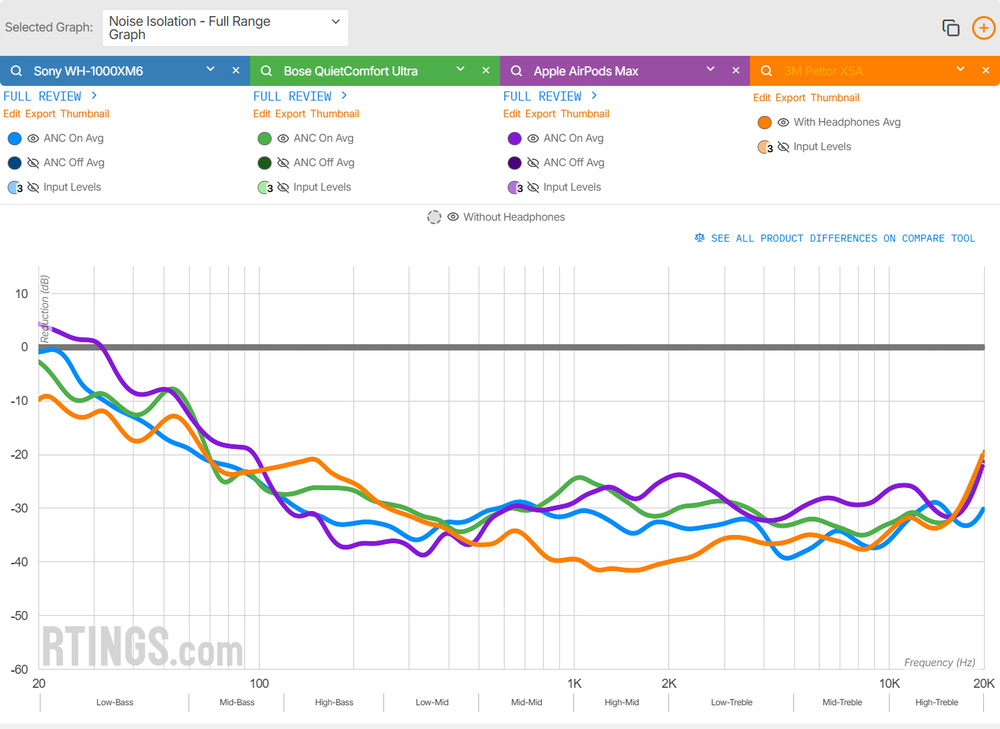
As you'd expect, the 3M Peltor X5A excel in the frequencies where passive isolation is the primary method of noise attenuation. However, the ANC headphones outperform the earmuffs in the lower frequencies (predominantly the high bass). Looking at the product's averaged attenuation based on frequency ranges better crystallizes the trend.
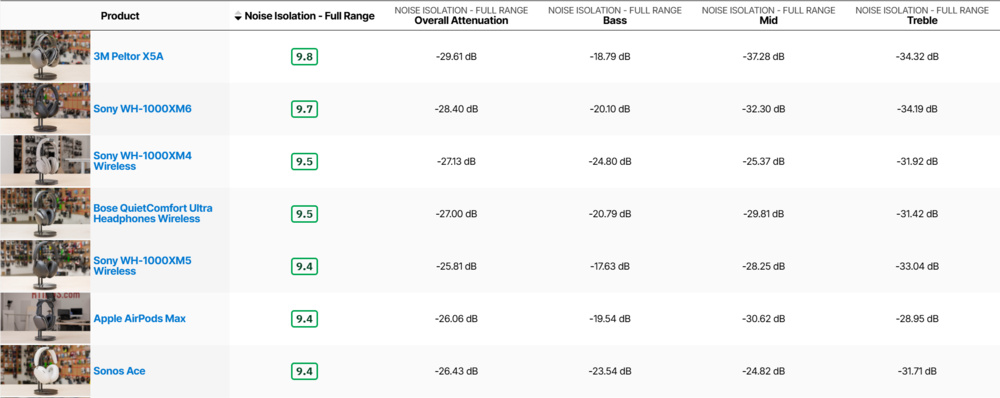
Why is there such a dramatic difference in bass range attenuation between purely passive earmuffs and noise cancelling headphones? The answer lies in the methods of noise attenuation. As mentioned earlier, passive isolation relies on materials, shape, size, and seal. But the longer waves in the bass range pass more easily through materials and are more challenging to absorb. With no noise-cancelling system to fall back on (though there are indeed ANC earmuffs on the market), the 3M Peltor X5A can't compete with our top-performing headphones in lower frequency attenuation.

Headphone Design Lessons From Earmuffs
If ANC headphones don't perform as well as earmuffs when attenuating higher frequencies, and passive isolation is predominantly responsible for noise reduction in this range, why don't headphone manufacturers simply copy earmuff design principles to improve headphone passive isolation? Manufacturers do take lessons from earmuff design principles, but they can't apply all of them due to comfort and practicality considerations.
Lesson 1: Clamping Force
High clamping force (which contributes to maintaining a strong seal) is one of the main factors that make earmuffs less comfortable than most headphones. The 3M Peltor X5A earmuffs have a clamping force of about 2 lbs, 0.3 lbs more than the highest headphone clamping force among the 840 headphones we've tested so far. High clamping forces can be fatiguing if the product is used for long periods, especially with earpads that aren't designed with comfort in mind.

Lesson 2: Depth and Dampening
Earmuffs also have large ear cup depth and thick padding to help improve attenuation. This isn't feasible for headphones, as they require room for drivers, a battery, and other electronics. People in the market for consumer headphones likely don't want to lug around heavy or cumbersome headphones, so manufacturers make the necessary trade-off between size and weight, and passive noise isolation performance.
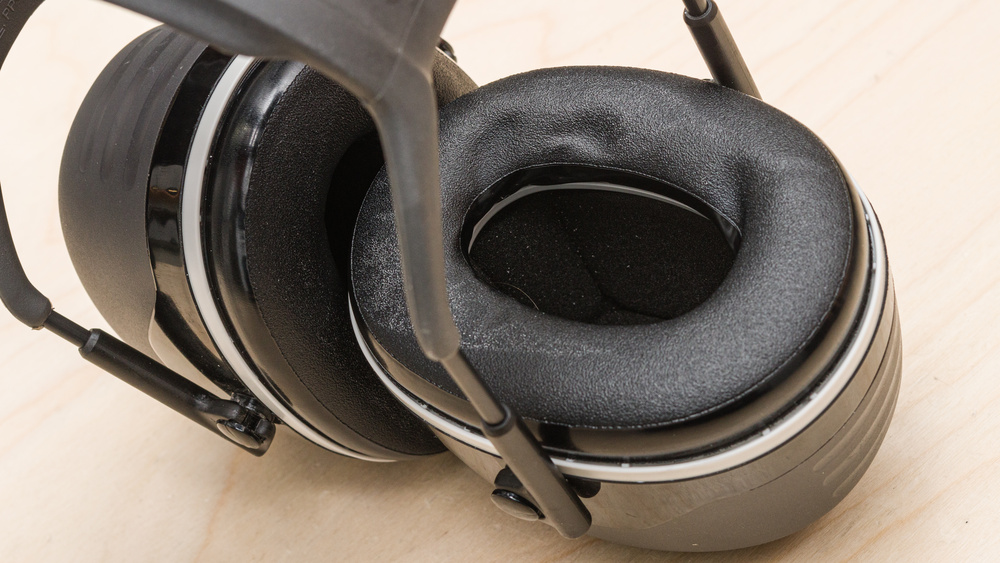 |
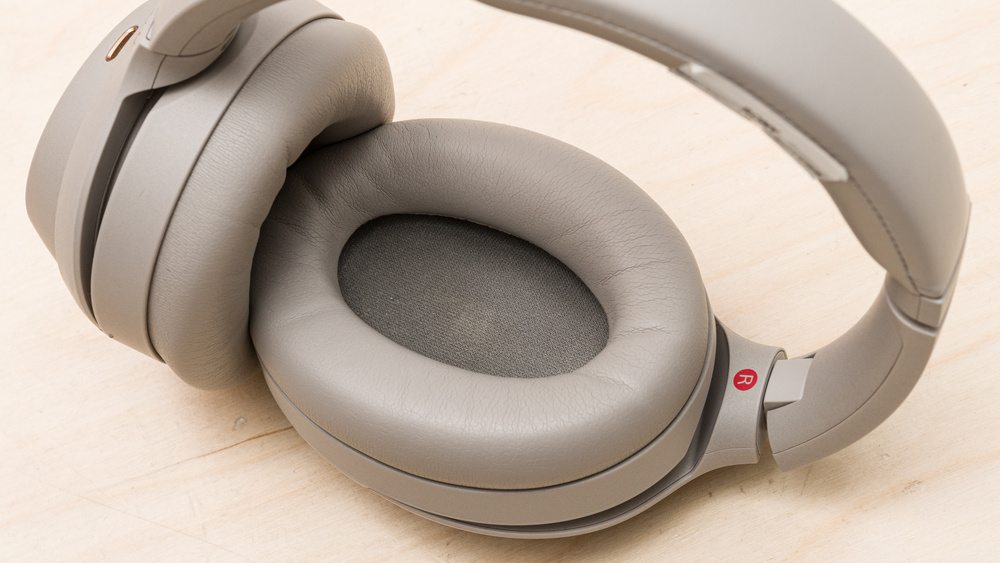 |
Lesson 3: Ear Pad Material
Ear cup material is one tool manufacturers can use to improve the passive isolation of headphones. The Logitech G PRO X 2 LIGHTSPEED serve as a perfect case study, as they come with two pairs of ear cups in different materials: cloth and leatherette.


The notable improvement in noise attenuation that the leatherette ear cup provides in the mid and treble range makes it clear that the seal provided by leather and leatherette ear cups improves passive isolation. While this is just a single example, the prominent use of leather or leatherette ear cups in most top-performing ANC headphones demonstrates manufacturer preference for the material, potentially for improved noise isolation performance.
Noise Cancelling Headphones Aren't Perfect
As you'd expect with technology this complex, ANC systems have quirks exclusive to the technology. We designed our tests around them, so you know what to expect in both theoretical and practical performance.
Headphones Behave Differently In Common Scenarios
Depending on the manufacturer's approach to ANC, some headphones take time to adapt to incoming background noise, taking a split second to process the information before reaching maximum noise attenuation. This behavior indicated that we needed to allow headphones to reach steady attenuation before evaluating their performance for the most comparable results between products.
ANC Response Times
One of the most popular ANC headphones, the Apple AirPods Max, exhibit this described delay when a new noise is introduced.
| Apple AirPods Max Airplane Noise Audio | Sony WH-1000XM4 Airplane Noise Audio |
Background audio samples used are from ETSI, accessible via the ETSI Open Database. You may need to increase your volume to hear the clip. Be sure to lower your volume afterward | |
Notice the Apple AirPods Max attenuation starts off weaker before reaching a consistent level a few seconds later? In comparison, the Sony WH-1000XM4 reach their maximum noise isolation effectiveness relatively quickly. We can also visualize this time delay by playing a tone at a constant level and observing how the headphones adapt.

Keep in mind that this 1000Hz tone is a single isolated frequency; in regular use, the AirPods Max have worse overall attenuation than the Sony WH-1000XM4 as they're forced to adjust to various frequencies over time. That said, the AirPods Max don't perform poorly by any stretch of the imagination; we focus on their shortcomings here as a means to illustrate our philosophy and test development process.
Adapting Our Testing For Delayed ANC
Our previous methodology used a sine sweep (a signal that changes frequency across time) to test noise isolation across the audible range. While this worked well for headphones that didn't take time to adjust or react, headphones like the Apple AirPods Max were penalized for their response time. Our approach has changed in three major ways:
- We use a pink noise signal as it's consistent over time and has equal energy per octave, perceived as flat for humans.
- We 'prime' headphones by playing the test signal for five seconds before taking measurements to allow for adaptation.
- We've updated our testing setup to simulate pseudo-diffuse field noise.


The resulting Noise Isolation – Full Range test is a solid baseline for evaluating headphones without considering variables like response time. However, background noise doesn't only come in the form of a consistent drone (of an airplane engine, for example). This is why we introduced a brand-new Noise Isolation – Common Scenarios test, where we evaluate headphones' attenuation against recordings of real-world noise.

What stands out most is the score gap reintroduced in this additional test. This is likely due to two main factors:
- The Sony WH-1000XM4 attenuate the bass range more effectively, which is quite prominent in the test recordings used.
- Background noise changes so frequently that the Apple AirPods Max's ANC can't adapt in time for optimal noise cancelling.
The Street Noise Isolation Audio sample adequately demonstrates the Apple AirPods Max's weaker performance responding to transient background noise relative to the Sony WH-1000XM4:
| Sony WH-1000XM4 | Airplane Noise Isolation Audio | Office Noise Isolation Audio | Street Noise Isolation Audio |
| Apple AirPods Max | Airplane Noise Isolation Audio | Office Noise Isolation Audio | Street Noise Isolation Audio |
Background audio samples used are from ETSI, accessible via the ETSI Open Database. You may need to increase your volume to hear the clip. Be sure to lower your volume afterward. | |||
To give you more information on how headphones perform in actual use, we also provide additional (unscored) Noise Isolation – Voice Handling recordings so you can hear how effectively (or ineffectively) headphones attenuate speech around you.
| Sony WH-1000XM4 | Female Voice 1 | Male Voice 1 | Female Voice 2 | Male Voice 2 |
| Apple AirPods Max | Female Voice 1 | Male Voice 1 | Female Voice 2 | Male Voice 2 |
Noise Isolation - Voice Handling recordings (original samples are from Peter Kabal, Telecommunications & Signal Processing Laboratory Multimedia Signal Processing at McGill University) | ||||
While taking time to respond to background noises seems to be a drawback for headphones attempting to cancel noises that change constantly, it's possible that this is an intended feature meant to increase the listener's awareness of their surroundings. We aren't sure whether this trend will continue in future headphone designs or if this is a limitation in processing that only some headphones exhibit. Either way, our new tests should allow us to fairly compare headphones for the foreseeable future, whether they need time to adjust or not.
ANC Headphones Struggle With Wind
If you've ever been on a phone call with someone outdoors on a windy day, you've probably already experienced wind noise, an obnoxious popping or fluttering sound picked up by the microphone. Unfortunately, the microphones used in noise cancelling headphones are also susceptible to this issue; when exposed to wind, ANC headphones can make more noise than if they didn't have ANC. To understand the interaction between the ANC headphones and wind, we need some background on the different types of ANC implementation.
Different Types Of ANC Implementation
There are three primary types of ANC implementation for consumer ANC headphones: feedforward, feedback, and hybrid. Each of these implementations refers to where the ANC microphones are positioned on the headphones.
 |
 |
 |
Feedforward: Microphones located on the outside of the ear cup (or ear canal for earbuds) capture sound before it gets to the wearer, process the audio, and then play anti-noise through the speaker. |
Feedback: Microphones are placed inside the ear cup (or ear canal for in-ears/earbuds). This method is more complex because the microphone will now pick up the non-noise audio from the speaker. |
Hybrid: Combines feedback and feedforward techniques. In this case, the headphones will have microphones both outside and inside the speaker. Hybrid is typically found in top-of-the-line headphone models. |
What Causes Wind Noise?
Now that we know where ANC microphones are typically located, we can better understand why wind is such an issue for so many ANC headphones. At first, it might seem counterintuitive that ANC headphones can't simply cancel out wind noise like any other sound. However, it's not as simple as it looks.
Compared to typical background noises, wind noise doesn't come from an external source; it's generated through the physical interaction of the wind with the headphones. This differs from the noise generated when wind hits other objects, like trees or windows. Those sounds will reach the headphones the same as any other external noise. The interaction between wind and the headphones creates a unique problem for ANC headphones with microphones outside the ear cup/canal (feedforward and hybrid).
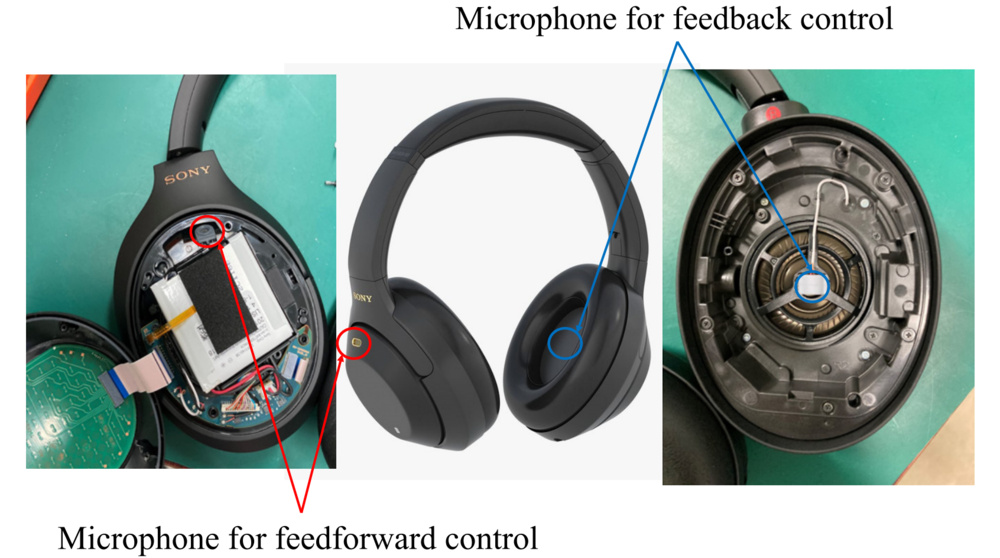
When wind hits a pair of headphones, the incident velocity is important in determining if there will be noise. At low velocity, wind will tend to stay in a laminar flow, not causing much noise. If the wind begins to move fast enough over the headphones, it can create turbulent airflow, which creates a shift in pressure over the microphones.

The microphones interpret this change in pressure as noise, so the ANC algorithm counters the 'phantom' noise with anti-noise. Additionally, since the airflow is turbulent, the velocity and pressure at any given point are likely to be different; if there are multiple ANC microphones, each is picking up a different perceived noise. The result is the ANC algorithm playing anti-noise in the headphones for 'phantom' noise that would never have made it to your ear, resulting in a louder experience than if the ANC weren't on in the first place.
| Sony WH-1000XM4 Wind Noise | 3M Peltor X5A Wind Noise |
The Sony WH-1000XM4 are particularly susceptible to wind noise, especially when compared to the fully passive 3M Peltor X5A. You may need to increase your volume to hear the clip. Be sure to lower your volume afterward | |
We test for wind noise by exposing headphones to fast airflow with an electric fan, adjusting the angle of the wind in both audio recordings and our graph. If you're curious about specifics, we cover more details in our noise isolation test article.
Conclusion
ANC headphones are an incredible way to listen to your favorite music or podcast while blocking out all the unwanted noise of your surroundings. We built our new test methodology to highlight ANC performance and allow for a fairer evaluation of headphones. And while ANC headphones continue to improve, earmuffs still provide a source of inspiration for the improvement of passive isolation on headphones.
Our new Full Range, Common Scenarios, and Voice Handling tests allow us to evaluate headphones that need time to respond to background noise. Though we don't know whether this is a limitation or a feature, our tests are built to handle the behavior fairly and comparably. Meanwhile, our new ANC Wind Handling test also highlights a glaring weakness of ANC.
As always, we would love your thoughts on our test philosophy; feel free to leave a comment or email us at feedback@rtings.com.
Recent Updates
09/10/2025: We've streamlined the article and updated some graphics to represent more recently released products.
04/04/2024: We published the article to walk users through our v1.7 methodology.
